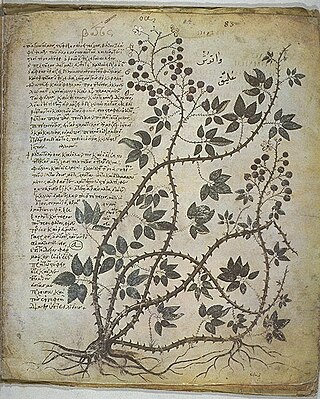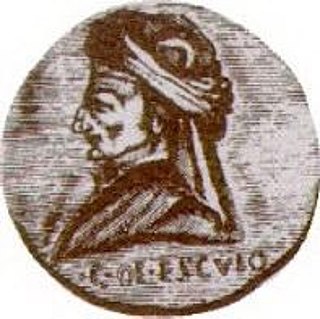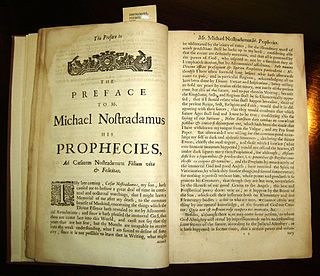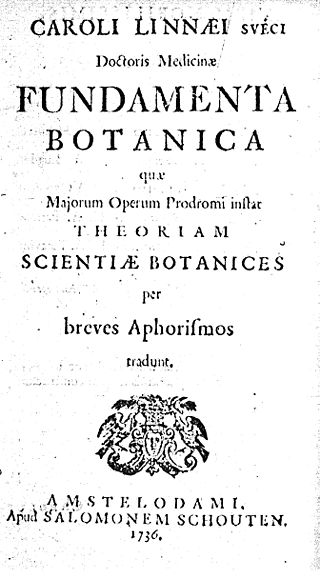Related Research Articles

Christine de Pizan or Pisan, was an Italian-born French poet and court writer for King Charles VI of France and several French dukes.

John Climacus, also known as John of the Ladder, John Scholasticus and John Sinaites, was a 6th–7th-century Christian monk at the monastery on Mount Sinai. He is revered as a saint by the Eastern Orthodox Church and Roman Catholic Church.

Joannes Stobaeus, from Stobi in Macedonia, was the compiler of a valuable series of extracts from Greek authors. The work was originally divided into two volumes containing two books each. The two volumes became separated in the manuscript tradition, and the first volume became known as the Extracts and the second volume became known as the Anthology. Modern editions now refer to both volumes as the Anthology. The Anthology contains extracts from hundreds of writers, especially poets, historians, orators, philosophers and physicians. The subjects range from natural philosophy, dialectics, and ethics, to politics, economics, and maxims of practical wisdom. The work preserves fragments of many authors and works which otherwise might be unknown today.
Bartholomaeus Anglicus, also known as Bartholomew the Englishman and Berthelet, was an early 13th-century Scholastic of Paris, a member of the Franciscan order. He was the author of the compendium De proprietatibus rerum, dated c.1240, an early forerunner of the encyclopedia and a widely cited book in the Middle Ages. Bartholomew also held senior positions within the church and was appointed Bishop of Łuków in what is now Poland, although he was not consecrated to that position.

John Arbuthnot FRS, often known simply as Dr Arbuthnot, was a Scottish physician, satirist and polymath in London. He is best remembered for his contributions to mathematics, his membership in the Scriblerus Club, and for inventing the figure of John Bull.

Materia medica is a Latin term from the history of pharmacy for the body of collected knowledge about the therapeutic properties of any substance used for healing. The term derives from the title of a work by the Ancient Greek physician Pedanius Dioscorides in the 1st century AD, De materia medica, 'On medical material'.

Johannes Leo Africanus was a Andalusi diplomat and author who is best known for his 1526 book Cosmographia et geographia de Affrica, later published by Giovanni Battista Ramusio as Descrittione dell'Africa in 1550, centered on the geography of the Maghreb and Nile Valley. The book was regarded among his scholarly peers in Europe as the most authoritative treatise on the subject until the modern exploration of Africa. For this work, Leo became a household name among European geographers. He converted from Islam to Christianity and changed his name to Johannes Leo de Medicis.

The Psychomachia is a poem by the Late Antique Latin poet Prudentius, from the early fifth century AD. It has been considered to be the first and most influential "pure" medieval allegory, the first in a long tradition of works as diverse as the Romance of the Rose, Everyman and Piers Plowman; however, a manuscript discovered in 1931 of a speech by the second-century academic skeptic philosopher Favorinus employs psychomachia, suggesting that he may have invented the technique.

The Annals by Roman historian and senator Tacitus is a history of the Roman Empire from the reign of Tiberius to that of Nero, the years AD 14–68. The Annals are an important source for modern understanding of the history of the Roman Empire during the 1st century AD; it is Tacitus' final work, and modern historians generally consider it his greatest writing. Historian Ronald Mellor calls it "Tacitus's crowning achievement", which represents the "pinnacle of Roman historical writing".
João Rodrigues de Castelo Branco, better known as Amato Lusitano and Amatus Lusitanus (1511–1568), was a notable Portuguese Jewish physician of the 16th century. Like Herophilus, Galen, Ibn al-Nafis, Michael Servetus, Realdo Colombo and William Harvey, he is credited as making a discovery in the circulation of the blood. He is said to have discovered the function of the valves in the circulation of the blood.

Cecco d'Ascoli is the popular name of Francesco degli Stabili, an Italian encyclopaedist, physician and poet. Cecco is the diminutive of Francesco, Ascoli was the place of his birth. The lunar crater Cichus is named after him.
The Epistle to Dr. Arbuthnot is a satire in poetic form written by Alexander Pope and addressed to his friend John Arbuthnot, a physician. It was first published in 1735 and composed in 1734, when Pope learned that Arbuthnot was dying. Pope described it as a memorial of their friendship. It has been called Pope's "most directly autobiographical work", in which he defends his practice in the genre of satire and attacks those who had been his opponents and rivals throughout his career.

Organon of the Art of Healing by Samuel Hahnemann, 1810, laid out the doctrine of his ideas of homoeopathy. The work was repeatedly revised by Hahnemann and published in six editions, with the name changed from the second onwards to Organon of Medicine, and has been so since the mid-19th century.

The Ladder of Divine Ascent or Ladder of Paradise is an important ascetical treatise for monasticism in Catholicism and Eastern Christianity, written by John Climacus in c. 600 AD; it was requested by John, Abbot of the Raithu monastery.

Theophilus de Garencières (1610–1680) was a French apothecary who spent most of his life practising in England.

Samuel Jones Gee was an English physician and paediatrician. In 1888, Gee published the first complete modern description of the clinical picture of coeliac disease, and theorised on the importance of diet in its control. His contribution led to the eponym Gee's disease. Gee is also credited with the first English-language description of cyclic vomiting syndrome.

Ludovico Marracci, also known by Luigi Marracci, was an Italian Oriental scholar and professor of Arabic in the College of Wisdom at Rome.
Primasius was bishop of Hadrumetum and primate of Byzacena, in Africa. One of the participants in the Three Chapters Controversy, his commentary on the Book of Revelation is of interest to modern scholars for its use of the lost commentary of Ticonius on the same book of the New Testament. According to M.L.W. Laistner, his disciples included the African theologian Junillus.

Fundamenta Botanica was one of the major works of the Swedish botanist, zoologist and physician Carl Linnaeus (1707–1778) and issued both as a separate work and as part of the Bibliotheca Botanica.
The Commentary on Anatomy in Avicenna's Canon is a manuscript written in the 13th century by the Arab physician Ibn al-Nafis. The manuscript was discovered in 1924 in the archives of the Prussian State Library in Berlin, Germany. It contains the earliest descriptions of the coronary circulation and pulmonary circulation systems.
References
- ↑ Landa, Louis A. (2015-12-08). English Literature, Volume 1: 1660-1800. Princeton University Press. p. 252. ISBN 978-1-4008-7732-4.